Please sign in first
Not a member?

- Home
- Online Education Programs
- ISG Journey Thru Gemology
- ISG Credentials
- Legacy Entrance
- Frequently Asked Questions
- Registry of Graduates
- Careers in Gemology
- Important Program Information
- About the ISG
- Why is the ISG Tuition So Low?
- Testimonials of ISG Students and Graduates
- Meet Your Instructor for your ISG education
- ISG Best Online Gemology School
- Graduate Support Programs
- Ishihara Color Vision Test
- Privacy Policy
- Newsletters
- The Story of Ruby
- Turquoise Investigation by the ISG
- The Story of Petrol Quartz
- Top 5 Myths About Jewelry Insurance Appraisals
- The Story of Time
- The Story of Freshwater Pearls
- The Story of Agates and Jaspers
- Susan Bailey v. Frantz Jewelers, et al.
- The Story of Blue Topaz
- The Story of Tibet Andesine
- The Story of Oregon Sunstone
- The Story of Created Moissanite
- Identifying Lab Created Diamonds
- Black Diamond or Created Moissanite?
- Ebay, the GIA, and Section 230
- Lessons From the Angry Janitor
- Exposing the Truth about Lab-Created Diamonds
- AGTA Hobbles Dealers and Buyers
- Appraisers -v- Gem Labs…a Legal Imbalance!
- Understanding the Classification of Diamonds
- Cremation Diamonds: Insuring and Litigating
- Let’s Talk About Gemology Credentials
- Hometown Jewelers and the Force Majeure Clause
- Following the Critical Angle of Diamond Grading
- When Breitling Brought the Airmen Home
- Let’s Open a Refractometer
- Measuring the Energy of Light
- Quick Reference Guide to Sunstone
- ISG Seeing the Invisible Light
- Contact Us
Identifying Lab Created Diamonds
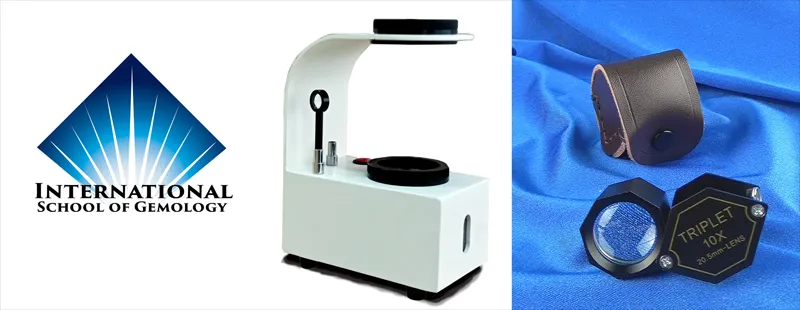
Identifying Lab Created Diamonds with a Polariscope
Credits: Randall Lightfoot, RGA, GG, pioneered this method of identifying lab-created diamonds. Sammantha Maclachlan, FGA, suggested the following application method to apply the concept. We recognize and thank these outstanding professionals for their contributions to this page.
For many years, grassroots-level jewelers and gemologists have struggled to identify lab-created diamonds. Most of this time, we relied on the major labs claiming to need high-dollar testing equipment to accomplish the task. Recent research by Randall Lightfoot, RGA, and others has revealed a very simple yet highly effective method to separate earth-mined diamonds from those lab diamonds grown by either the High-Pressure, High-Temperature (HPHT) method or the Chemical Vapor Deposition (CVD) method. After testing this concept with over 100 diamonds of various of these three sources, I found Mr. Lightfoot’s research reporting to be absolutely accurate. 100% accurate, in fact.
In a recent post on our Facebook page, one of our most respected mentors, Sammantha Maclachlan, FGA, suggested a very simple method of applying Randall’s research utilizing a polariscope and 10x jeweler’s loupe. This method makes identifying lab-created diamonds quite easy, at least within certain parameters. Here is the story.
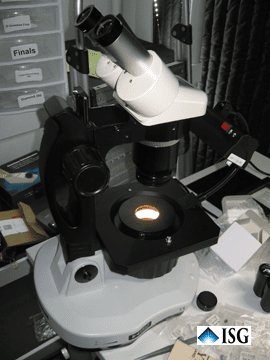 Those who attended our recent Comprehensive Gem Identification class here in San Antonio got a hands-on look through our Meiji Techno GEMT2-BFDF with Rotating Polarizers (seen at left) to view the easily identifiable differences in earth-mined, HPHT, and CVD-grown diamonds through crossed polarizing filters. The images below were taken through our microscope, showing the differences between these types.
Those who attended our recent Comprehensive Gem Identification class here in San Antonio got a hands-on look through our Meiji Techno GEMT2-BFDF with Rotating Polarizers (seen at left) to view the easily identifiable differences in earth-mined, HPHT, and CVD-grown diamonds through crossed polarizing filters. The images below were taken through our microscope, showing the differences between these types.
But the question is: Do you need an expensive microscope to accomplish this?
The answer is: No!
Here is the set up
The concept is simple. Use the tabletop polariscope as your crossed polarizing filter, which is, in reality, what a polariscope truly is. And use a 10x loupe as the magnifier. Hold the diamond just right. And Voila! You can separate earth-mined diamonds from HPHT and CVD lab-grown diamonds without the big labs. Of course, this only works on larger diamonds with which you can get a proper viewing angle, but I will have more on that shortly.
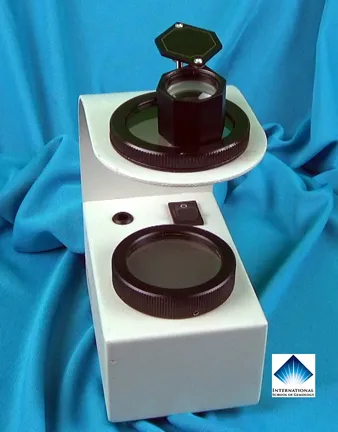
#1. Place the loupe on top of the polariscope, as seen on the left.
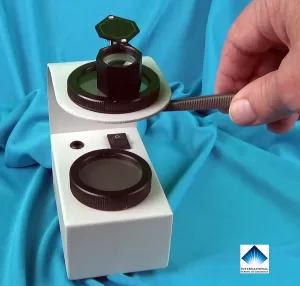 #2. With the polariscope in the dark position (and, of course, the other lights off) place the diamond just under the upper polarizing filter as seen here.
#2. With the polariscope in the dark position (and, of course, the other lights off) place the diamond just under the upper polarizing filter as seen here.
#3. Rotate the stone around and view the reactions. Below is what you will see with a little patience and practice.
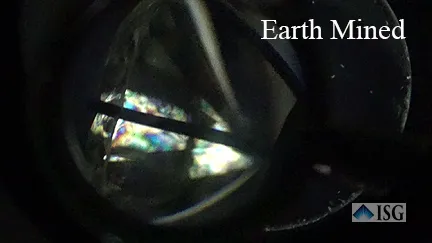
Here you see the blotchy coloring of the internal strain colors of a natural, earth-mined diamond. As you rotate the diamond, the colors will be like a kaleidoscope of nebulous colors that spread out across the diamond facets facing you.
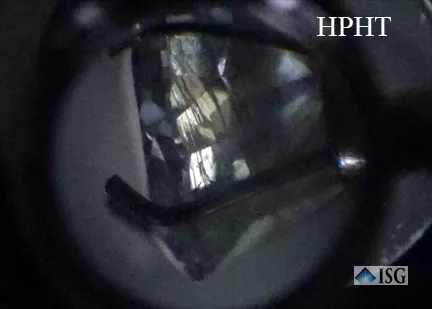
Diamonds created by the HPHT method will be clear with no strain colors. You may see reflections of inclusions or your stone holder as is the case at left. But no rainbow type colors as seen above. Just plain colorless, clear facets facing you.

CVD created diamonds will be very easy to see as the strain pattern created by the CVD method imparts clearly visible linear stress formations inside the diamond. We have over 60 CVD created diamonds from various sources in the ISG lab and 100% of the CVD created diamonds presented this optical feature.
Of course, this only works on loose diamonds and those set diamonds that can be viewed through the polariscope filters. So what about smaller melee diamonds, diamonds in settings that cannot be viewed using this method, and other situations where the diamond cannot be clearly viewed through our polariscope diamond tester?
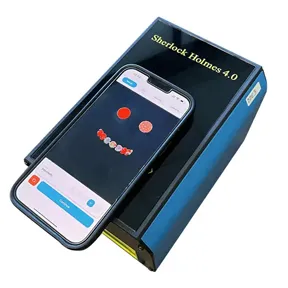 For that, I recommend the only lab-created diamond identifier I have found to be accurate, the Yehuda Sherlock Holmes Diamond Detector from Sy Kessler. They have no idea I am posting this here, and no promotional consideration is in play. This is just my opinion after testing many of the testers that claim to identify lab-created diamonds but only test for Type II diamond UV transparency. You can learn more by clicking on the image at left and visiting the Kessler website. They are very good people to work with.
For that, I recommend the only lab-created diamond identifier I have found to be accurate, the Yehuda Sherlock Holmes Diamond Detector from Sy Kessler. They have no idea I am posting this here, and no promotional consideration is in play. This is just my opinion after testing many of the testers that claim to identify lab-created diamonds but only test for Type II diamond UV transparency. You can learn more by clicking on the image at left and visiting the Kessler website. They are very good people to work with.
The bottom line is that the above polariscope test is accurate for larger loose diamonds and those diamonds in settings that can be viewed through the polarizing filters of a polariscope. After testing dozens of diamonds of various origins, it has proven to be 100% accurate. For the other testing, I have found no other tool to be as accurate as the Yehuda detector.
Lab-created diamonds are here to stay. They are a growing market, which means a growing revenue stream for someone. Rather than be afraid and fight that tide, why not embrace change and take advantage of that revenue stream? There will always be a demand for earth-mined diamonds, but there is a growing demand for lab-created diamonds.
Now, you can be confident that you can identify both and expand your revenue streams.
We will soon have a video out further demonstrating this concept.